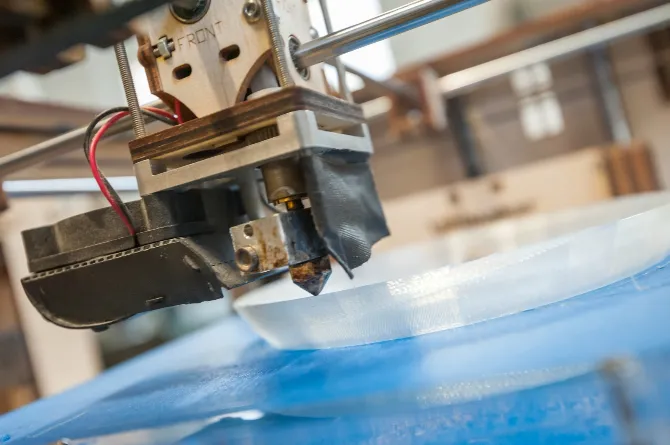
The world’s first single-piece 3D-printed engine is set to be tested when Agnikul Cosmos, a Chennai-based aerospace startup, conducts a test flight for its Agnibaan mobile launch system by the end of December. The indigenously developed Agnilet engine was successfully test-fired in 2021 and marks a major milestone for additive manufacturing (AM) in India, popularly known as 3D printing—a technology which has made significant strides in recent years. Apart from its obvious application in construction, AM is now being used extensively in key sectors like automobile, aircraft, and aerospace, not to mention its invaluable contribution to the medical industry. With the incorporation of emerging technologies like Artificial Intelligence (AI) and 4D Printing, AM is poised to become one of the primary drivers of industrial growth in the future.
What is AM?
While the foundation of AM was laid in the early 1980s through a process called rapid prototyping, the technology came into its own by the 2000s, when it could finally produce functional objects. AM uses computer-aided design (CAD) or a 3D object scan to create a layer-by-layer framework, which is subsequently sent to a 3D printer, thereby creating a physical object directly from the digital design. This is in contrast to traditional or subtractive manufacturing, which relies on removing excess materials from a larger object via processes like drilling, boring, grinding or cutting, to obtain the final product. Furthermore, AM allows a wide variety of materials to be used, such as ceramics, metals, thermoplastics, foams, gels and biomaterials.
The indigenously developed Agnilet engine was successfully test-fired in 2021 and marks a major milestone for additive manufacturing (AM) in India, popularly known as 3D printing—a technology which has made significant strides in recent years.
AM has several advantages over traditional manufacturing, the ability to create precise geometrical shapes being the most prominent among them. Coupled with the freedom to use a much larger number of materials allows the creation of parts which perform better and weigh much less than their conventional counterparts. This turns out to be particularly important in the case of automobiles, aircrafts and the aerospace industry, where precision and weight can have a sizeable impact on performance. For instance, 3D-printed aircraft components such as titanium brackets are now being extensively used by Airbus, particularly in its A350 aircraft.
AM makes it much more convenient to produce small to medium lot sizes and this is the area where it can have maximum impact and utility. Producing small lots is not a cost-effective endeavor with traditional manufacturing thanks to setup costs. AM eliminates most of these costs and makes it significantly cheaper to manufacture customised products. This is particularly useful for medical applications, where prosthetics, implants, and artificial organs specifically tailored to individuals are required. Hearing aids, for example, are now almost exclusively 3D-printed.
In addition to industrial applications, AM is also becoming increasingly viable for individual use, with equipment prices declining significantly over the past decade. The average cost of a consumer-level 3D printer is currently around US$ 700, which can go down to as low as US$ 100 for entry-level printers. This provides yet another avenue where AM trumps conventional manufacturing and has substantial room to grow.
AM technology is evolving at a rapid pace and has now become a US$13.16 billion industry, with a compound annual growth rate of 22 percent. The incorporation of AI is further aiding in the digital design process and will continue streamlining it in the future. The advent of 4D printing also presents exciting new prospects. While AM builds 3D objects which remain fixed, 4D printing can create objects with the added ability to evolve or reconfigure themselves over time. This is typically achieved by using “smart materials” like shape memory polymers, which can undergo shape transformation when exposed to external environmental stimuli like temperature, pressure or light. This can have potential applications in extreme environments like space or even biomedical applications like self-reconfiguring proteins. MIT’s Self-Assembly Lab is one of the pioneering institutions in this domain.
Adoption of AM in India
The Ministry of Electronics and Information Technology (MeitY) released the “National Strategy for Additive Manufacturing” in February 2022, which aims to create a more conducive environment for the development and deployment of AM technologies, while encouraging its adoption by local manufacturers, thereby making India a global hub for AM. It also envisions a 5 percent share of the global AM market for India by 2025, adding nearly US$ 1 billion to its GDP. The plan to achieve this entails creating 50 India-specific technologies, 100 new startups, and 100,000 new skilled labour, among others.
AM technology is evolving at a rapid pace and has now become a US$13.16 billion industry, with a compound annual growth rate of 22 percent. The incorporation of AI is further aiding in the digital design process and will continue streamlining it in the future.
A 3D Printing/Additive Manufacturing Lab was established at the National Institute of Electronics and Information Technology, Aurangabad. In June 2023, the National Centre for Additive Manufacturing was set up by MeitY in collaboration with the Government of Telangana. It will serve as the apex body in the realm of AM in India and work to accelerate its adoption while also promoting R&D and skill development by involving multiple stakeholders from academia, industry and government. Andhra Pradesh Medtech Zone has collaborated with the University of Wollongong, Australia to set up a 3D Bioprinting Lab at Visakhapatnam.
In the private sector, companies like INTECH, Wipro and Amace have been leading the charge in AM technology. INTECH is responsible for manufacturing India’s first metal 3D printer, along with multiple software to aid AM processes and a digital academy. Wipro 3D launched “AddWize” in 2020 to accelerate the adoption of metal 3D printing by organisations within India. It signed a memorandum of understanding with Hindustan Aeronautics Limited (HAL) to design and develop 3D-printed aerospace components and subsequently manufactured aircraft components to be installed in HAL-manufactured helicopter engines. It also recently launched an indigenously developed industrial-grade 3D printer. Amace additively manufactured India’s National Emblem, which was attached to the wheels of the Pragyaan Rover in ISRO’s Chandrayaan-3 mission.
How AM can be Invaluable in the Indian Context
Though India lags considerably behind global leaders in AM like the US, UK and China, it has significantly ramped up its efforts in R&D, investment and adoption of the technology in recent years. More important perhaps, and what can make the country truly stand out, are the prospects AM lays out for construction and housing. The construction of India’s first 3D-printed house by the Indian Institute of Technology (IIT), Madras startup Tvasta in 2021, has laid the foundation for how AM could potentially revolutionise the sector if implemented on a mass scale. As opposed to conventional construction which can take up to five months, AM can be employed to construct houses in less than five days, while reducing costs by more than 30 percent.
In August 2023, India’s first 3D-printed post office was inaugurated in Bengaluru. Developed by L&T Construction in collaboration with IIT-Madras, the Ulsoor Bazaar Post Office was completed in just 43 days with a budget of less than INR 25 lakh. On 22 November 2023, Apsuja Infratech and Simpliforge Creations completed the world’s first 3D-printed temple in Siddipet, Telangana. Consisting of three sanctums and covering an area of about 4,000 square feet, the temple took about three months to complete.
The implications AM has for rural housing alone makes it worthwhile for India to accelerate its efforts in the field, especially considering the fact that it possesses one of the largest slums in the world. Though the respected finance minister had pointed out that “….it would not be a big challenge to build 100 million houses by 2022” while inaugurating the aforementioned house at Madras, no concrete steps have been taken in this direction. The invaluable contribution of AM to the medical field, not to mention its increasing utility in the aerospace industry, should add further impetus to the cause. And while the discourse on emerging technologies like AI has been becoming increasingly widespread as of late, it has been relatively sparse when it comes to a game-changing technology like AM, which seems to get lost in the shuffle, despite its obvious relevance in the Indian context.
Prateek Tripathi is a Research Assistant Centre For Security Strategy and Technology at Observer Research Foundation
The views expressed above belong to the author(s). ORF research and analyses now available on Telegram! Click here to access our curated content — blogs, longforms and interviews.




 PREV
PREV


